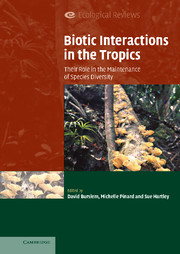Book contents
- Frontmatter
- Contents
- List of contributors
- Preface
- PART I Plant–plant interactions
- PART II Plant–microbe interactions
- PART III Plant–animal interactions
- PART IV Biotic interactions in human-dominated landscapes
- 18 The alteration of biotic interactions in fragmented tropical forests
- 19 Effects of natural enemies on tropical woody-plant invasions
- 20 New mix of alien and native species coexists in Puerto Rico's landscapes
- 21 The dynamics of a tropical dry forest in India: climate, fire, elephants and the evolution of life-history strategies
- 22 Changes in plant communities associated with timber management in natural forests in the moist tropics
- Index
- References
22 - Changes in plant communities associated with timber management in natural forests in the moist tropics
Published online by Cambridge University Press: 25 August 2009
- Frontmatter
- Contents
- List of contributors
- Preface
- PART I Plant–plant interactions
- PART II Plant–microbe interactions
- PART III Plant–animal interactions
- PART IV Biotic interactions in human-dominated landscapes
- 18 The alteration of biotic interactions in fragmented tropical forests
- 19 Effects of natural enemies on tropical woody-plant invasions
- 20 New mix of alien and native species coexists in Puerto Rico's landscapes
- 21 The dynamics of a tropical dry forest in India: climate, fire, elephants and the evolution of life-history strategies
- 22 Changes in plant communities associated with timber management in natural forests in the moist tropics
- Index
- References
Summary
Introduction
Disturbance is integral to a forest's ecology, and selective logging is a form of disturbance. Whether disturbance is natural or anthropogenic, it is likely that the biotic interactions within the system are influenced by it. This volume attests to the importance of biotic interactions to tropical forest function and diversity. And while there are still many unknowns in how interactions change with perturbation, particularly when the impacts are as variable as those associated with timber management, an understanding of these changes is important to inform the development of management interventions that are ecologically sustainable, i.e. where the manipulations stay within the limits of natural disturbance patterns for the forests (e.g. ecological forestry, sensu Seymour & Hunter 1999) and where ecosystem functions are maintained (Forest Stewardship Council (FSC) 2000).
Generally, approaches to the study of impacts of logging and other silvicultural interventions are based on comparisons, for example control versus impact designs where unlogged, old-growth forests are used as the control (Johns 1983; Lambert 1992; Silva et al. 1995), or various treatments are compared, for example different logging systems (Johns et al. 1996; Pinard & Putz 1996), different harvest intensities (Kasenene 1987; Panfil & Gullison 1998; van der Hout 1999), or different stand-improvement treatments (Fox & Chai 1982; de Graaf et al. 1999; Gerwing 2001). But as with other forms of anthropogenic impacts, detecting change is difficult because of the complexity and variability (temporal and spatial) of natural systems (Underwood 1991, 1993).
- Type
- Chapter
- Information
- Biotic Interactions in the TropicsTheir Role in the Maintenance of Species Diversity, pp. 530 - 552Publisher: Cambridge University PressPrint publication year: 2005
References
- 1
- Cited by

